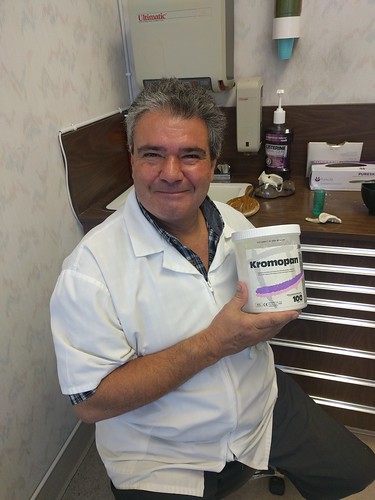Carrageenans, Phycocolloids and other really big words!
I learned a lot of big words while traveling: phycocolloids, carrageenans, alginate, agar-agar, etc. I told myself that this vocabulary would be very useful for Scrabble. But because of hearing so much about them with Algonauts along the way, I kind of needed to understand what they meant.
So what are these phyco-thingy, carraghé-thingamajig and algina-whatsitsname? I opted for the option “phone call to a friend” and contacted Professor Eric Deslandes of the University of Brest who works on carrageenans.
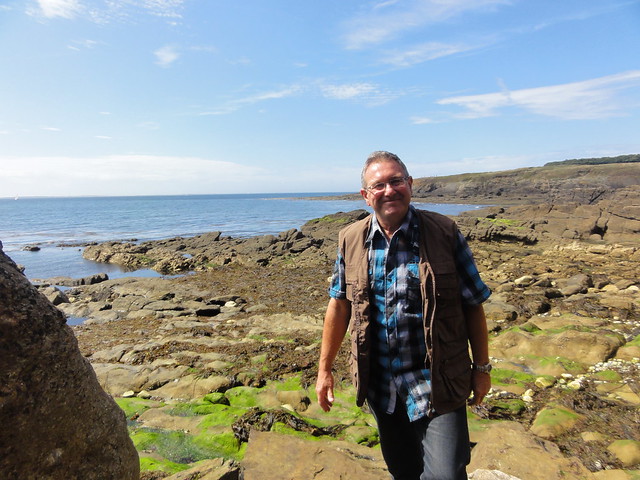
Eric Deslandes, France
Carrageewhat?
“Eric Deslandes: Carrageenans. It’s indeed a funny name. Moreover, the etymology is not certain: the word carrageenan could derive from the name of a place in Ireland (Carrigeen), but perhaps also from the Celtic origin word “carraigin” which means “little rock”. Maybe because in these areas, the algae that contain carrageenans grow on small rocks? Well, for getting back to your question, carrageenans are polymers made of polysaccharides.
-
Jacqueline Algane: Stop. I do not understand.
-
Eric Deslandes: Macromolecules…
-
Jacqueline Algane: I do not understand.
-
Eric Deslandes: Big molecules. Carrageenans are compounds which are extracted from certain red seaweeds. Those are big sugars, also called carbohydrates: the same unit of simple sugar is repeated and forms a chain. We could say that they are polysugars but the term used is polysaccharide. Do you know starch? It is a complex carbohydrate produced by terrestrial plants: this large sugar molecule is composed of glucose units. For carrageenans, it is also a chain but in the basic unit is another simple sugar, galactose. Besides, you may hear the word galactans for talking about carrageenans.
Every living cell, animal or vegetable, is defined by a membrane and in plants, this membrane is lined with a cell wall. This is largely composed of cellulose in terrestrial plants. For algae, the wall compounds are different. If you take a look at the algae in their natural environment, you will immediately understand how these compounds are useful and original: their function is to act as a glue between the cells of the seaweed. They give to the seaweed its suppleness and its elasticity so that they can then resist waves and currents.
- Jacqueline Algane: When we see them on the foreshore, they seem mostly slimy and sticky.
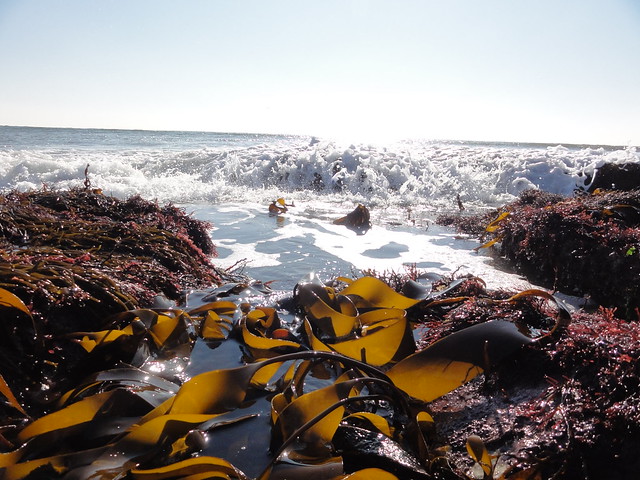
Seaweeds on the shore
-
Eric Deslandes: It is precisely these wall compounds that give this aspect to seaweeds! And a good reason for humans to use them. The compounds extracted from these algae will have gelling, thickening, binding properties, etc. They can be very useful for applications in food-processing industry, cosmetics, textile industry, etc. You alright Jacqueline? You follow? Ready for a little more vocabulary?
-
Jacqueline Algane: Yes, I’m hanging on!
-
Eric Deslandes: Carrageenans are extracted from some species of red seaweeds. But the type of compounds in the cell wall is not the same in all the algae species. Other red seaweed species are exploited because they contain another type of gelling compound, agar-agar. Brown seaweeds are also harvested and employed to extract alginate molecules. Alginates and agars are widely used in industry and are present products that are used daily1, such as dental impression.
All these compounds are grouped under the word phycocolloids.
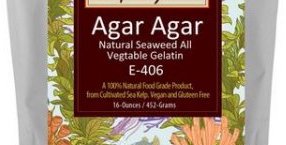
-
Jacqueline Algane: …
-
Eric Deslandes: Jacqueline?
-
Jacqueline Algane: …
-
Eric Deslandes: Jacqueline? Hello? Hello?
-
Jacqueline Algane: I’m still online… In spite of being warned, these terms are heavy!
-
Eric Deslandes: Yes, it’s true that they are all high molecular weight compounds!
-
Jacqueline Algane: I think I recognize the Greek root phykos
-
Eric Deslandes: Absolutely! phykos for algae and the Greek word kolla which means glue.
Industrial uses
-
Jacqueline Algane: Well, let’s stick to carrageenans for the time being. What do we do with that?
-
Eric Deslandes: You have certainly eaten carrageenans without knowing it Jacqueline! It is found in many consumer products in the food industry, cosmetics or pharmaceuticals. They are sometimes hidden in the list of ingredients under the code E407 or E407b.
-
Jacqueline Algane: Are they special operative agents?
-
Eric Deslandes: Yes, texturing agents. They are used to adjust the viscosity. Carrageenans react particularly well with milk because they trap calcium atoms between their long chains. This forms a milk gel responsible of the creaminess of ice creams or desserts creams that are commercially available.
-
Jacqueline Algane: Seaweed in my ice cream… I’ll never get used to it!
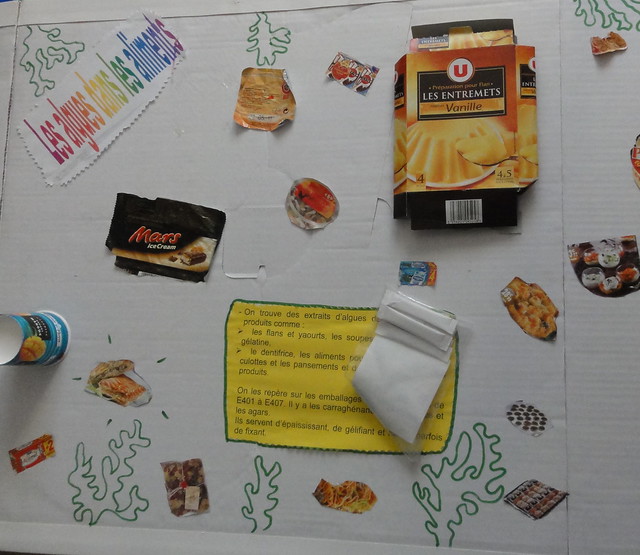
Schoolchildren of Cléden-Cap-Sizun looked for consumer products containing seaweed extracts
- Eric Deslandes: Not only in ice cream, but also in many prepared dishes. Carrageenans can thicken sauces, soups, some energy drinks. They are also involved in the process of preparing deli meats, beers and animal feed. They follow you into your bathroom whether it’s in your toothpaste or some of your cosmetics. Not to mention all the precise and very important applications in the fields of biotechnology or pharmacy! These polysaccharides will have properties similar to gelatin and are therefore suitable for vegetarians or those whose does not consume pork for religious reasons. In the 90s’, the mad cow crisis2 led to a renewed interest for carrageenans: with seaweed extracts, no risk of prion! There is also a lot of potential: research has shown that a carrageenan-based gel could prevent contamination by viruses, such as the common cold virus but also the papillomavirus that can induce cancer3. The research is still ongoing, but who knows one day perhaps these seaweed extracts will play a major role in the field of health.
Carrageenans of the world
-
Jacqueline Algane: Do all the red seaweeds contain them?
-
Eric Deslandes: We don’t find them in all species, nor in the same proportions. In addition, there are three main types of carrageenans:
kappa-,
iota- and
lambda.
Here the Greek letters do not designate college sororities, but the types of carrageenans with different viscosity power: more or less gelling, more or less thickening.
Some species of red seaweeds are exploited throughout the world for the extraction of carrageenans, some of which are very present on our coasts in Brittany: you may have heard about the pioka or petit goémon?
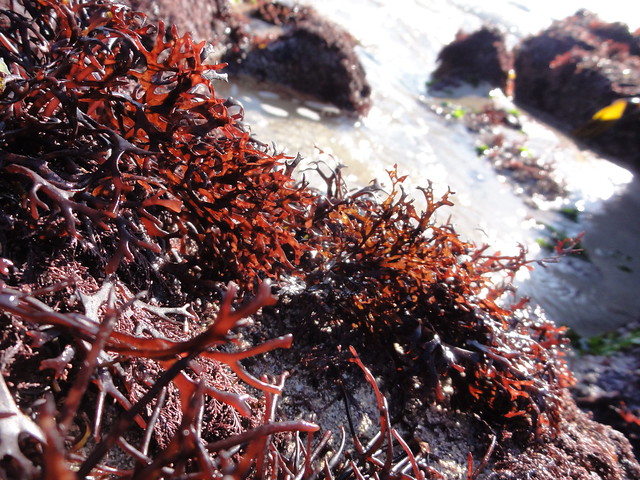
Chondrus crispus et Mastocarpus stellatus in Plogoff, France
-
Jacqueline Algane: Oh yes, we were also calling it: lichen or bezhin ru. We used to make desserts like blanc-mange with it. I understand now: actually we were making custards with seaweeds!
-
Eric Deslandes: It’s the specie Chondrus crispus. Mastocarpus and Gigartina are also harvested for these uses. It was a traditional activity in Ireland too. Moreover, the English term used for this alga is often “Irish moss”. Today, 80% of the carrageenans we use in France come from South East Asia and from the large-scale cultivation of two genres of tropical algae, Eucheuma and Kappaphycus: they grow relatively quickly, have the desired quality of carrageenan and their cost price is lower. I think you have been able to observe these algae on many occasions.
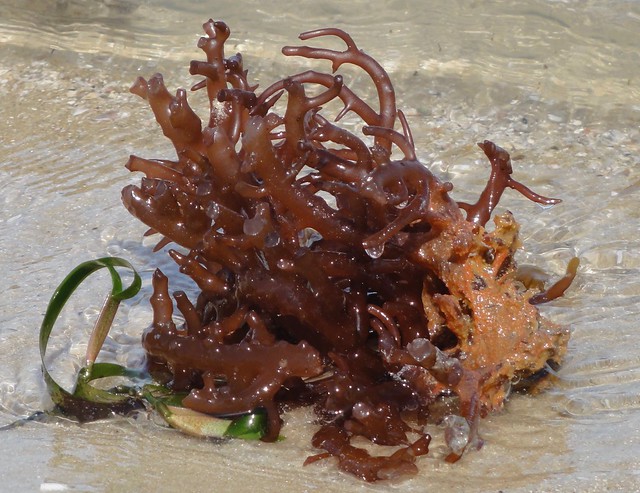
Kappaphycus alvarezii in Rameshwaran, India
-
Jacqueline Algane: Yes, I remember “Kappa-Ficus” - initially I thought we were talking about a shrub! I observed it in India, the Philippines, Indonesia and Malaysia in particular.
-
Eric Deslandes: These last 3 countries are part of the Coral Triangle and are the main producers of Kappaphycus. This tropical algae is native to the Philippines and has been introduced in nearly 20 countries over the past 40 years. The development of these seaweed crops is an illustration of the opportunities and challenges of sustainable development.
From the economic and social point of view, the development of seaweed farming has allowed coastal populations to rise from poverty or to diversify the activities of fishermen. From an environmental point of view, it must be ensured that the development of these large-scale cultivation does not disrupt the functioning of ecosystems, hence the research and the monitoring that sometimes take time before these introductions4. Around the world, research teams are conducting work for developing the most sustainable production and working conditions.”
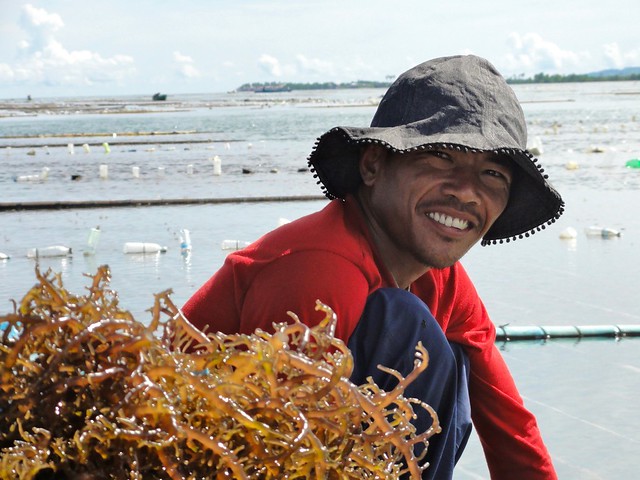
Cultivateur d’algues à Zamboanga aux Philippines.
After all these explanations, let’s go to the supermarket to find the algae hidden under the code names E401 to E407b!
Learn more:
Carrageenans on TV (in French)
TV news on France 2 channel, August 2nd, 2017
Notes from the text:
-
See Seaweed everywhere! ↩
-
In the 1990s, several countries experienced an epizootic disease of bovine spongiform encephalopathy (BSE), a degenerative infection of the nervous system of cattle caused by a prion. In 1996, scientists discovered the possibility of transmission to humans of this pathology (known for the human form as Creutzfeldt-Jakob disease) by consumption of beef. The result is a health and economic crisis with the decrease in beef consumption. More info ↩
-
Roberts, J.N., Buck, C.B., Thompson, C.D., Kines, R., Bernardo, M., Choyke, P.L., Lowy D.R. & Schiller, J.T. (2007). Genital transmission of HPV in a mouse model is potentiated by nonoxynol-9 and inhibited by carrageenan. Nature Medicine, 13 (7), 857-861. ↩
-
As it is the case, for example, in Brazil, discover the interview with Leila Hayashi ↩
